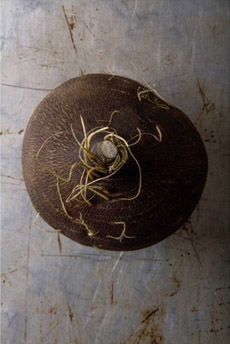TIP OF THE DAY: Black Radish
|
As part of our Winter Vegetable Doldrums Series, today’s focus is the black radish*, Raphanus sativus niger. It’s a member of the anti-carcinogenic Brassica family of cruciferous† vegetables.
Available year round, black radishes peak in winter and early spring. Significantly larger than traditional radishes, it average threes to four inches in diameter or length, and can be round or cylindrical and elongated, depending upon the variety. The skin is black or dark brown and the flesh is familiarly radishy, crisp, white and slightly bitter with a hot bite. A lot of the bite is int he skin, so the radish can be peeled for a milder flavor. SERVING IDEAS Black radishes can be enjoyed raw or cooked in a variety of different preparations. |
It’s a black radish. Look for it in better produce sections (we found ours at Whole Foods) and farmers markets. Photo courtesy The Chef’s Garden. |
|
|
Here’s a general radish tip: If the radish has too much bite, you can tone down the peppery heat. Simply slice, salt and rinse with water. *Other names include Spanish radish, Gros Noir d’Hiver, Noir Gros de Paris and the Black Mooli. †Other Brassica family members include bok choy, broccoli, brussels sprouts, cabbage, cauliflower, collard greens, kale and mustard greens, among others. |
||
 Black radish salad. Photo courtesy The Chef’s Garden. |
BLACK RADISH RECIPES
Believed to be a relative of the wild radish, the black radish was first cultivated in the eastern Mediterranean. An ancient vegetable, radishes were grown in Egypt before the pyramids were built. Black radishes are an excellent source of vitamin C and also provide iron, magnesium, potassium and vitamins A, E and B. They are known for their ability to fight off infection and promote healthy digestive function. A component, raphanin, has been shown to be beneficial in treatment of thyroid imbalances. The leaves have a liver detoxifying effect. |
|
|
The black radish has long been used in folk medicine in both Europe and China, to stimulate bile function and improve gall bladder health promoting. In Chinese medicine, the black radish is also used to promote pulmonary and respiratory health. To store black radishes, remove the greens and wrap the bulbs in plastic. They will keep crisp if refrigerated, for up to two weeks.
|
||



